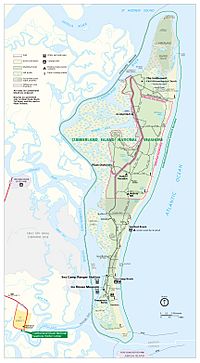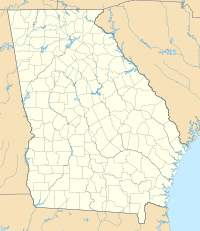Fort St. Andrews facts for kids
Quick facts for kids Fort St. Andrews |
|
|---|---|
| Cumberland Island, Georgia | |

Map of Cumberland Island (note the fort would have been located on North West part of the island near Terrapin Point).
|
|
| Coordinates | 30°55′33″N 81°27′04″W / 30.925735°N 81.451188°W |
| Type | Coastal defense fortification |
| Site history | |
| Materials | Earthen, Palisade |
| Battles/wars | Invasion of Georgia (1742) |
Fort St. Andrews was an important British fort built in 1736. It was located on Cumberland Island, Georgia, along the coast. The British built this fort to protect their new colony of Georgia. It acted as a "buffer" or protective barrier against Spanish Florida to the south. The fort was later left empty and then destroyed by the Spanish in 1742.
Why Was Fort St. Andrews Built?
In 1732, General James Oglethorpe led the British effort to settle Georgia. He chose Savannah as the main port for the new colony. Spain, however, also claimed this land as part of its Florida colony. They saw the British settlement as illegal.
To protect Georgia, General Oglethorpe created a defense plan. He built Fort Frederica on St. Simons Island in 1736. This was near the mouth of the Altamaha River. Oglethorpe knew that Georgia's coast had many barrier islands. These islands created a natural water path, called the inland passage. This passage offered protection from rough ocean weather.
What Was Fort St. Andrews Like?
Fort St. Andrews was built in 1736 on the northern tip of Cumberland Island. This spot is now known as Terrapin Point. The fort faced the inland passage. It was designed like a "star work" or star fort. This means it had four points, like a star. This design helped prevent "dead zones" where attackers could hide.
The main fort was about 65 feet (20 meters) by 130 feet (40 meters). At the bottom of the hill, there was a triangular water battery. This battery had a wooden fence, called a palisade. It was made to fire at enemy ships coming in. A covered path connected this battery to the main fort.
Another battery was on the western side of the island. This protected the approach through the inland waterway. Soldiers lived in a nearby village of huts called Barrimacke. In 1738, about 200 soldiers were stationed at Fort St. Andrews. A smaller group of about 50 or 60 men was on the southern end of Cumberland Island. The fort's main job was to protect Darien and Frederica to the north.
Challenges and the Spanish Invasion
In 1738, some British soldiers faced very tough living conditions. They also did not get extra pay they expected for their sea journey. This caused problems among the troops. General Oglethorpe and his officers were able to calm the situation and regain control.
In 1739, a conflict known as the War of Jenkins' Ear began. Spain started planning an invasion of Georgia. The Spanish governor, Don Manuel de Montiano, led the invasion force. In June 1742, about 15 Spanish ships arrived at Cumberland Island. They took shelter near Fort St. Andrews in St. Andrew Sound.
General Oglethorpe ordered the fort to be left empty. The British troops moved south to Fort William. In July, the Spanish forces retreated after the Battle of Bloody Marsh. On their way back to Florida, they camped at the empty Fort St. Andrews. They then burned it down. After this, a group of British rangers stayed at the fort's ruins for several years. However, Fort St. Andrews was never rebuilt.


